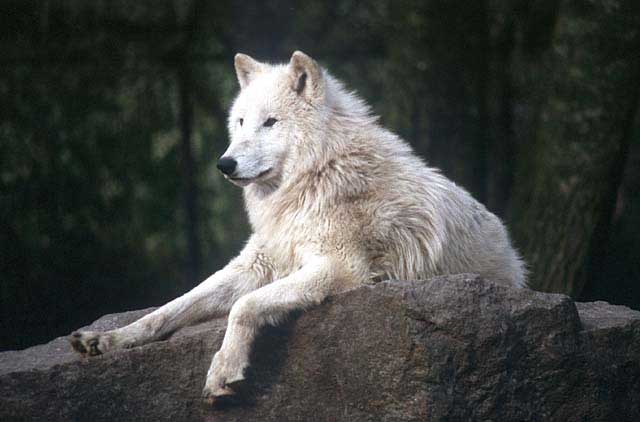
Canis lupus albus (*)
Superregnum: Eukaryota
Cladus: Unikonta
Cladus: Opisthokonta
Cladus: Holozoa
Regnum: Animalia
Subregnum: Eumetazoa
Cladus: Bilateria
Cladus: Nephrozoa
Superphylum: Deuterostomia
Phylum: Chordata
Subphylum: Vertebrata
Infraphylum: Gnathostomata
Megaclassis: Osteichthyes
Cladus: Sarcopterygii
Cladus: Rhipidistia
Cladus: Tetrapodomorpha
Cladus: Eotetrapodiformes
Cladus: Elpistostegalia
Superclassis: Tetrapoda
Cladus: Reptiliomorpha
Cladus: Amniota
Cladus: Synapsida
Cladus: Eupelycosauria
Cladus: Sphenacodontia
Cladus: Sphenacodontoidea
Cladus: Therapsida
Cladus: Theriodontia
Cladus: Cynodontia
Cladus: Eucynodontia
Cladus: Probainognathia
Cladus: Prozostrodontia
Cladus: Mammaliaformes
Classis: Mammalia
Subclassis: Trechnotheria
Infraclassis: Zatheria
Supercohors: Theria
Cohors: Eutheria
Infraclassis: Placentalia
Cladus: Boreoeutheria
Superordo: Laurasiatheria
Cladus: Ferae
Ordo: Carnivora
Subordo: Caniformia
Familia: Canidae
Subfamilia: Caninae
Tribus: Canini
Genus: Canis
Species: Canis lupus
Subspecies: Canis lupus albus
Name
Canis lupus albus Kerr, 1792
Synonyms
Canis lupus dybowskii Domaniewski, 1926
Canis lupus kamtschaticus Dybowski, 1922
Canis lupus turuchanensis Ognev, 1923
References
Canis lupus albus in Mammal Species of the World.
Wilson, Don E. & Reeder, DeeAnn M. (Editors) 2005. Mammal Species of the World – A Taxonomic and Geographic Reference. Third edition. ISBN 0-8018-8221-4.
Canis lupus albus Kerr, 1792 – Taxon details on Integrated Taxonomic Information System (ITIS).
Vernacular names
català: Llop de la tundra
Deutsch: Tundrawolf
Ελληνικά: Λύκος της τούνδρας
English: Tundra Wolf
español: Lobo de la tundra
suomi: Tundrasusi
magyar: Tundrafarkas
italiano: Lupo della tundra
norsk: Hvitulv
polski: Wilk syberyjski
português: Lobo-da-tundra
русский: Тундровый волк
The tundra wolf (Canis lupus albus), also known as the Turukhan wolf,[3] is a subspecies of grey wolf native to Eurasia's tundra and forest-tundra zones from Finland to the Kamchatka Peninsula.[3] It was first described in 1792 by Robert Kerr, who described it as living around the Yenisei, and of having a highly valued pelt.[4]
Description
It is a large subspecies, with adult males measuring 118–137 cm (46.5–54 in) in body length, and females 112–136 cm (44–53.5 in). Although often written to be larger than C. l. lupus, this is untrue, as heavier members of the latter subspecies have been recorded. Average weight is 40–49 kg (88–108 lb) for males and 36.6–41 kg (81–90 lb) for females. The highest weight recorded among 500 wolves caught in the Taymyr Peninsula and the Kanin Peninsula during 1951-1961 was from an old male killed on the Taymyr at the north of the Dudypta River weighing 52 kg (115 lb). The fur is very long, dense, fluffy, and soft, and is usually light grey in colour. The lower fur is lead-grey and the upper fur is reddish-grey.[5]
Habitat
The tundra wolf generally rests in river valleys, thickets and forest clearings.[6] In winter it feeds almost exclusively on female or young wild and domestic reindeer, though hares, arctic foxes and other animals are sometimes targeted. The stomach contents of 74 wolves caught in the Nenets Autonomous Okrug in the 1950s were found to consist of 93.1% reindeer remains. In the summer period, tundra wolves feed extensively on birds and small rodents, as well as newborn reindeer calves.[7]
References
"The revival of wolves and other large predators and its impact on farmers and their livelihood in rural regions of Europe" (PDF). europarl.europa.eu.
Wozencraft, W. C. (2005). "Order Carnivora". In Wilson, D. E.; Reeder, D. M. (eds.). Mammal Species of the World: A Taxonomic and Geographic Reference (3rd ed.). Johns Hopkins University Press. pp. 532–628. ISBN 978-0-8018-8221-0. OCLC 62265494.
Mech, L. David (1981), The Wolf: The Ecology and Behaviour of an Endangered Species, University of Minnesota Press, p. 353, ISBN 0-8166-1026-6
Kerr, R. (1792), The animal kingdom, or zoological system, of the celebrated Sir Charles Linnæus: containing a complete systematic description, arrangement, and nomenclature, of all the known species and varieties of the mammalia, or animals which give suck to their young, Printed for A. Strahan, and T. Cadell, London, and W. Creech, Edinburgh, p. 137
Heptner, V. G. & Naumov, N., P. (1998) Mammals of the Soviet Union Vol. II Part 1a, SIRENIA AND CARNIVORA (Sea cows; Wolves and Bears), Science Publishers, Inc., USA, pp. 182-184, ISBN 1-886106-81-9
Heptner, V. G. & Naumov, N., P. (1998) Mammals of the Soviet Union Vol. II Part 1a, SIRENIA AND CARNIVORA (Sea cows; Wolves and Bears), Science Publishers, Inc., USA, p. 210, ISBN 1-886106-81-9
Heptner, V. G. & Naumov, N., P. (1998) Mammals of the Soviet Union Vol. II Part 1a, SIRENIA AND CARNIVORA (Sea cows; Wolves and Bears), Science Publishers, Inc., USA, p. 216, ISBN 1-886106-81-9
Retrieved from "http://en.wikipedia.org/"
All text is available under the terms of the GNU Free Documentation License

